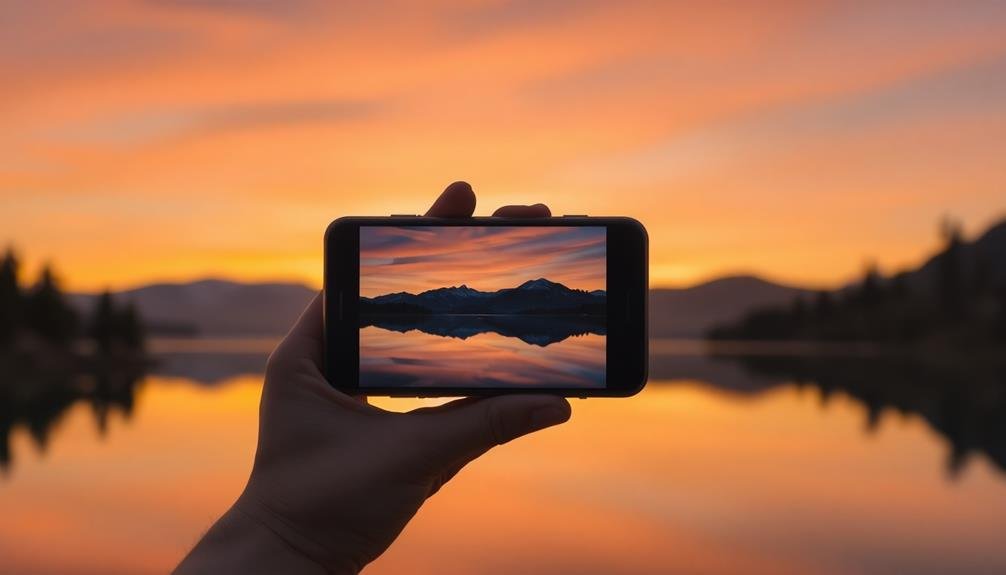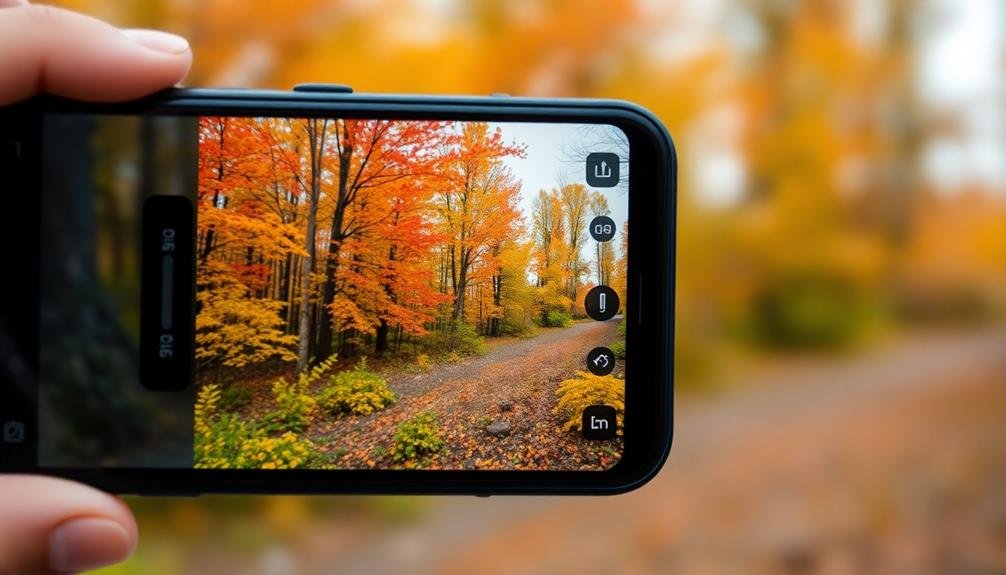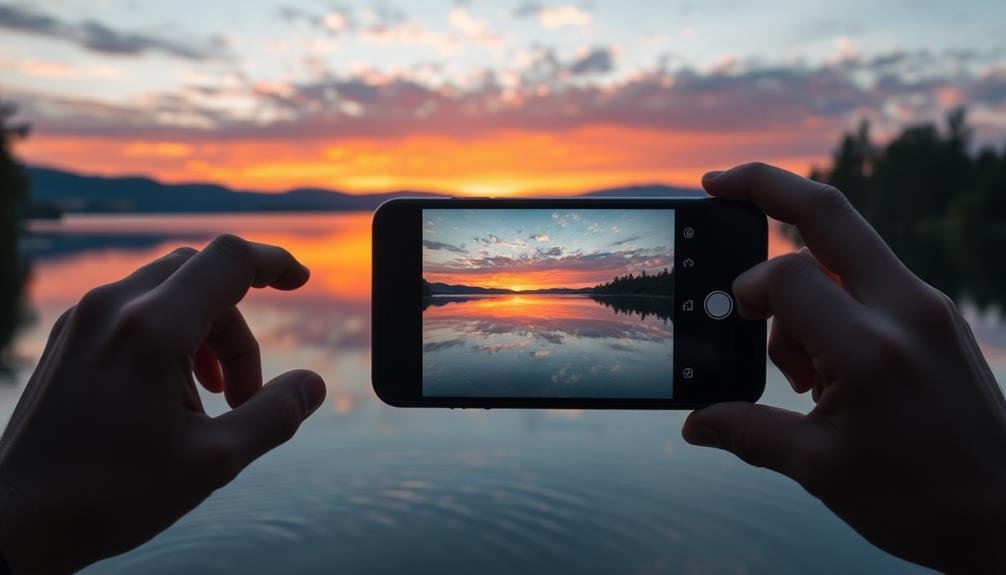To mirror nature's beauty with your smartphone, start by finding perfect reflection spots like calm water surfaces or glass buildings. Next, master your camera settings, focusing on exposure controls and HDR mode for balanced shots in tricky lighting. Finally, compose stunning reflection images by positioning your camera low and using the grid feature to align horizons. Don't forget to experiment with aspect ratios and consider shooting during golden hour for dramatic effects. With these three mobile camera tricks, you'll capture nature's splendor in ways you never imagined. Dive deeper to reveal even more secrets of smartphone photography.
Find Perfect Reflection Spots

After a rainfall, puddles become your canvas for stunning reflection shots. Look for calm water surfaces that mirror the sky, buildings, or nature. Position your phone's camera low, almost touching the water, to capture the full reflection. Experiment with different angles to find the most enthralling composition.
Don't limit yourself to puddles. Seek out other reflective surfaces like glass buildings, polished car hoods, or even sunglasses. These unexpected mirrors can add depth and intrigue to your photos.
For the clearest reflections, shoot during the golden hour—just after sunrise or before sunset. The soft, warm light enhances colors and creates a dreamy atmosphere. If you're shooting in bright daylight, use a polarizing filter to reduce glare and intensify reflections.
Remember, symmetry is key in reflection photography. Align your shot so the real subject and its reflection create a balanced image. You can also play with partial reflections, capturing just a fragment of the scene for a more abstract look.
Lastly, don't be afraid to edit your photos. Adjust contrast and saturation to make reflections pop, turning ordinary scenes into extraordinary images.
Master Smartphone Camera Settings

Before diving into advanced techniques, it's crucial to master your smartphone's basic camera settings. Start by familiarizing yourself with the exposure controls. Tap on the screen to focus, then adjust the brightness by sliding your finger up or down. This simple trick can greatly improve your shots in challenging lighting conditions.
Next, explore your camera's HDR (High Dynamic Range) mode. It's particularly useful for scenes with high contrast, like landscapes with bright skies and darker foregrounds. HDR takes multiple exposures and combines them, resulting in a more balanced image.
Don't overlook your phone's grid feature. Enable it to help compose your shots using the rule of thirds. This guideline can greatly enhance your photo's visual appeal and balance.
Experiment with different aspect ratios. While the default is often 4:3, trying 16:9 or 1:1 can lead to more creative compositions.
Compose Stunning Reflection Shots

Reflections offer a unique way to add depth and intrigue to your mobile photography. To capture stunning reflection shots, seek out smooth, reflective surfaces like calm lakes, puddles, or even glass buildings.
Position your camera low to the ground to maximize the reflected image's size and impact. Experiment with different angles to find the perfect balance between the subject and its reflection.
Use your smartphone's grid feature to align the horizon with the rule of thirds, creating a more balanced composition. To enhance the reflection's clarity, try using a polarizing filter or adjusting your camera's exposure settings. Underexposing slightly can often make reflections more vivid.
Don't limit yourself to natural reflections. Get creative with mirrors, metallic surfaces, or even sunglasses to craft unique compositions.
Play with symmetry by centering your subject and its reflection, or create contrast by focusing on just a portion of the reflected image.
For added drama, capture reflections during golden hour or blue hour when the light is soft and colorful.
Remember to keep your lens clean and steady your hand to guarantee sharp, clear images that showcase the mesmerizing beauty of reflections.
Frequently Asked Questions
How Do I Protect My Phone From Water Damage While Taking Reflection Shots?
To protect your phone from water damage during reflection shots, you'll want to use a waterproof case or bag. Don't submerge your device; instead, hold it just above the water's surface. Consider using a tripod for stability.
Can I Use Filters or Editing Apps to Enhance Reflection Photographs?
Yes, you can enhance reflection photos with filters and editing apps. They'll help you adjust contrast, brightness, and colors. Try apps like Snapseed or VSCO for versatile editing tools. Experiment with different effects to make your reflections pop.
What Time of Day Is Best for Capturing Reflections in Nature?
You'll find the best reflections in nature during the golden hours – just after sunrise or before sunset. Early morning often provides calm waters, while late afternoon offers warm, dramatic light. Don't forget to explore misty conditions too!
Are There Any Legal Considerations When Photographing Reflections in Public Spaces?
When photographing reflections in public spaces, you'll need to be aware of privacy laws. Don't capture people without consent, respect private property, and avoid commercial use without permission. Always check local regulations before shooting.
How Can I Create Artificial Reflections When Natural Ones Aren't Available?
You can create artificial reflections by using props like mirrors, glass, or water surfaces. Place them strategically to capture reflections of your subject. You'll also find apps that add reflection effects to your photos post-capture.
In Summary
You've now got the tools to capture breathtaking reflections with your smartphone. Remember to scout for ideal reflection spots, master your camera settings, and compose your shots creatively. With practice, you'll transform ordinary scenes into extraordinary images. Don't be afraid to experiment and push your boundaries. Nature's beauty is all around you, waiting to be mirrored in your unique perspective. So grab your phone and start capturing those mesmerizing reflections today!





Leave a Reply